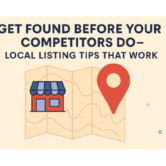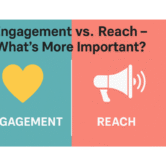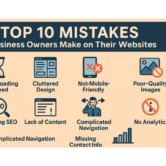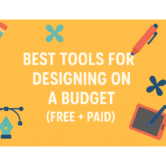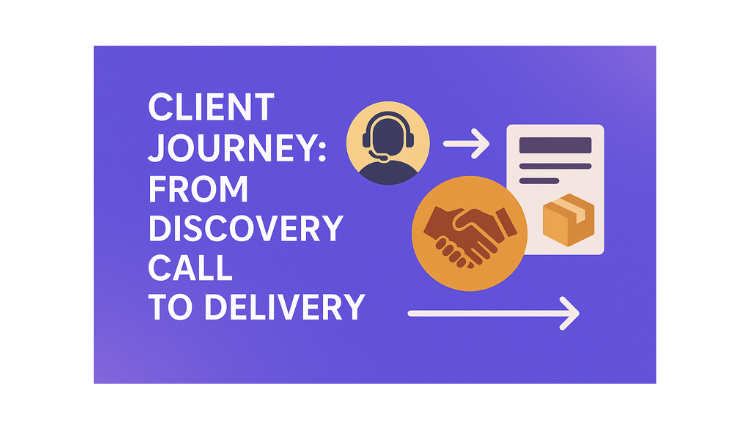
“Client Journey: From Discovery Call to Delivery”
You could introduce Help me Buddy IT Services early on, explaining that your company helps facilitate smooth client journeys or offers support throughout these stages.
“A seamless client journey is crucial for building trust and ensuring successful project delivery. If you’re looking for a trusted partner to guide you through each step, Help me Buddy IT Services offers end-to-end solutions for your business
introduction
Creating a seamless and engaging client journey is essential for building trust, fostering strong relationships, and ensuring successful project outcomes. From the initial discovery call to the final delivery, each step should align with your brand’s values and aesthetic while providing a professional and memorable experience. This step-by-step guide will walk you through designing a client journey that reflects your brand’s identity and leaves a lasting impression.
Why the Client Journey Matters
A well-crafted client journey does more than guide clients from point A to point B—it showcases your professionalism, sets clear expectations, and builds confidence in your services. By aligning each touchpoint with your brand’s aesthetic and values, you create a cohesive experience that feels personal and intentional, increasing client satisfaction and loyalty.
Step 1: Define Your Brand’s Aesthetic and Tone
Before mapping out the client journey, establish your brand’s aesthetic and communication style. This ensures consistency across all interactions.
- Identify Core Elements: Define your brand’s colors, fonts, and visual style. For example, a minimalist brand might use neutral tones and clean lines, while a creative agency could opt for bold colors and playful graphics.
- Set the Tone: Decide how you want to communicate—professional, approachable, or creative. This tone should carry through emails, calls, and deliverables.
- Create Templates: Develop branded templates for emails, proposals, and invoices using tools like Canva or Adobe Express to maintain visual consistency.
Pro Tip: Use a mood board to visualize your brand’s aesthetic. Tools like Pinterest or Milanote can help you collect inspiration.
Step 2: Craft a Memorable Discovery Call
The discovery call is your first opportunity to connect with a potential client and set the tone for the journey.
- Preparation is Key: Research the client’s business and goals beforehand. Prepare a branded slide deck or PDF to share during the call.
- Personalize the Experience: Use the client’s name, reference their industry, and tailor your pitch to their needs.
- Showcase Your Brand: Incorporate your brand’s colors and logo into any visuals. For example, a branded Zoom background or presentation slide can make a professional impression.
- Ask Strategic Questions: Use questions like, “What challenges are you facing?” or “What does success look like for this project?” to understand their needs.
Action Item: Create a discovery call checklist with branded elements like a welcome slide or agenda to guide the conversation.
“During the discovery call, the goal is to understand the client’s needs and determine how you can provide value. If you’re looking for expert assistance to streamline your discovery process, Help me Buddy IT Services can help set up efficient systems and strategies for your business. Get in touch with us for a tailored consultation.”
Step 3: Send a Professional Proposal
After the discovery call, send a polished proposal that reflects your brand and outlines the project scope.
- Design a Branded Proposal: Use tools like Canva, Proposify, or Google Docs to create a visually appealing document. Include your logo, brand colors, and clean typography.
- Be Clear and Concise: Outline the project scope, timeline, deliverables, and pricing. Use bullet points or infographics for clarity.
- Add a Personal Touch: Reference specific points from the discovery call to show you’ve listened to their needs.
Pro Tip: Include a “Next Steps” section in your proposal to guide the client on how to move forward, such as signing the contract or scheduling a kickoff call.
Step 4: Onboard with Ease
The onboarding phase sets expectations and builds excitement for the project.
- Send a Welcome Packet: Create a branded welcome packet (PDF or online portal) that includes a project overview, timeline, and FAQs.
- Use Collaboration Tools: Set up tools like Trello, Asana, or Notion to keep the client informed and engaged. Customize these tools with your brand’s colors and logos.
- Schedule a Kickoff Call: Use this call to align on goals, introduce team members, and confirm the timeline.
Action Item: Design a branded onboarding checklist or timeline graphic to share with clients.
Step 5: Maintain Clear Communication Throughout the Project
Consistent, branded communication keeps clients informed and confident in your process.
- Regular Updates: Send weekly or bi-weekly updates via email or your project management tool. Use branded email templates for a professional look.
- Be Responsive: Reply to client inquiries promptly and maintain your brand’s tone in all communications.
- Use Visuals: Share progress updates with branded visuals, like mockups or progress charts, to keep clients engaged.
Pro Tip: Automate updates using tools like Zapier or ActiveCampaign to save time while maintaining a personal touch.
Step 6: Deliver with Impact
The delivery phase is your chance to wow the client and solidify their trust in your brand.
- Package Deliverables Thoughtfully: Present final deliverables in a branded format, such as a PDF portfolio, a custom webpage, or a branded folder in Google Drive.
- Include a Thank-You Note: Add a personalized, branded thank-you note to express gratitude and reinforce your brand’s warmth.
- Request Feedback: Send a branded feedback form (via Google Forms or Typeform) to gather insights and testimonials.
Action Item: Create a branded delivery template, such as a final presentation slide deck or a handover document.
Step 7: Follow Up and Nurture the Relationship
The client journey doesn’t end at delivery—follow-up is key to building long-term relationships.
- Send a Follow-Up Email: Check in a week or two after delivery to ensure the client is satisfied. Use a branded email template for consistency.
- Offer Additional Value: Share a case study, a blog post, or a resource related to their project to stay top of mind.
- Encourage Repeat Business: Offer a branded loyalty discount or referral incentive to encourage future collaborations.
Pro Tip: Add clients to a branded newsletter (via Mailchimp or ConvertKit) to keep them engaged with your brand.
Tools to Elevate Your Client Journey
- Canva: For branded templates, proposals, and visuals.
- Trello/Asana: For project management and client collaboration.
- Proposify: For professional, branded proposals.
- Typeform/Google Forms: For feedback and discovery call questionnaires.
- Calendly: For seamless scheduling of calls.
“The client journey is an ongoing process that requires attention to detail at every step. If you want expert help at any stage, whether it’s the discovery call, proposal creation, or final delivery, Help me Buddy IT Service
Final Thoughts
A well-designed client journey not only ensures a smooth process but also reinforces your brand’s identity at every step. By aligning each touchpoint with your aesthetic and values, you create a professional, cohesive experience that leaves clients impressed and eager to work with you again. Start by auditing your current process, identifying gaps, and incorporating branded elements to elevate the journey from discovery call to delivery.










